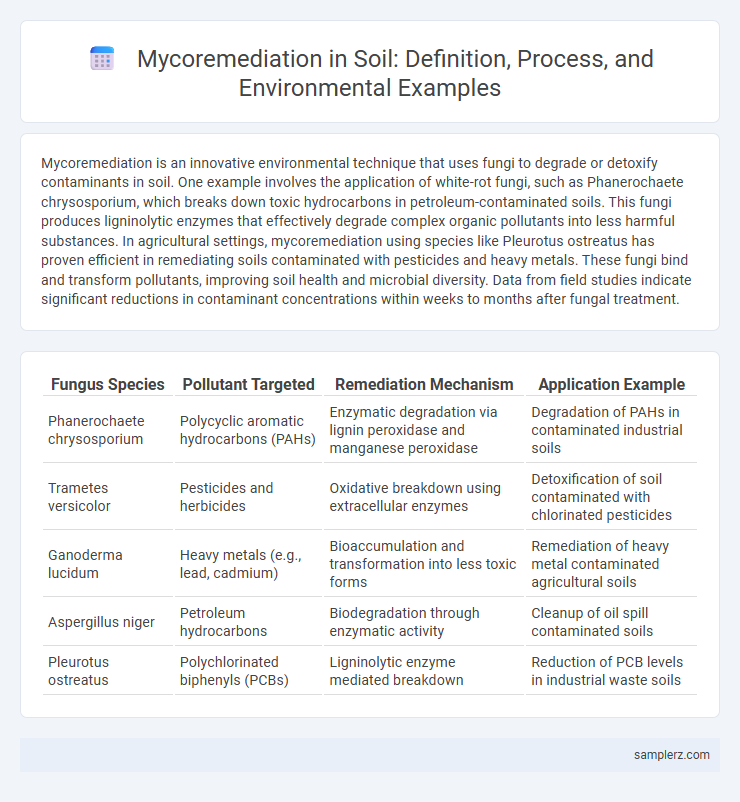Mycoremediation is an innovative environmental technique that uses fungi to degrade or detoxify contaminants in soil. One example involves the application of white-rot fungi, such as Phanerochaete chrysosporium, which breaks down toxic hydrocarbons in petroleum-contaminated soils. This fungi produces ligninolytic enzymes that effectively degrade complex organic pollutants into less harmful substances. In agricultural settings, mycoremediation using species like Pleurotus ostreatus has proven efficient in remediating soils contaminated with pesticides and heavy metals. These fungi bind and transform pollutants, improving soil health and microbial diversity. Data from field studies indicate significant reductions in contaminant concentrations within weeks to months after fungal treatment.
Table of Comparison
| Fungus Species | Pollutant Targeted | Remediation Mechanism | Application Example |
|---|---|---|---|
| Phanerochaete chrysosporium | Polycyclic aromatic hydrocarbons (PAHs) | Enzymatic degradation via lignin peroxidase and manganese peroxidase | Degradation of PAHs in contaminated industrial soils |
| Trametes versicolor | Pesticides and herbicides | Oxidative breakdown using extracellular enzymes | Detoxification of soil contaminated with chlorinated pesticides |
| Ganoderma lucidum | Heavy metals (e.g., lead, cadmium) | Bioaccumulation and transformation into less toxic forms | Remediation of heavy metal contaminated agricultural soils |
| Aspergillus niger | Petroleum hydrocarbons | Biodegradation through enzymatic activity | Cleanup of oil spill contaminated soils |
| Pleurotus ostreatus | Polychlorinated biphenyls (PCBs) | Ligninolytic enzyme mediated breakdown | Reduction of PCB levels in industrial waste soils |
Introduction to Mycoremediation in Soil
Mycoremediation employs fungi to degrade or sequester soil contaminants, effectively restoring polluted environments by breaking down hazardous chemicals like petroleum hydrocarbons and heavy metals. Species such as Pleurotus ostreatus and Phanerochaete chrysosporium produce enzymes that target complex pollutants, enhancing soil quality and promoting ecosystem recovery. This eco-friendly technique offers a sustainable alternative to traditional soil remediation methods by harnessing fungi's natural biodegradation capabilities.
Mechanisms of Fungal Degradation in Soil
Fungal mycoremediation in soil involves enzymatic degradation mechanisms where fungi secrete ligninolytic enzymes such as laccases, peroxidases, and manganese peroxidases that break down complex organic pollutants like polycyclic aromatic hydrocarbons (PAHs) and pesticides. These extracellular enzymes oxidize contaminants, converting toxic compounds into non-toxic metabolites through mineralization or transformation processes. The fungal hyphal network penetrates soil matrices, facilitating pollutant bioavailability and enhancing degradation efficiency in contaminated environments.
Case Study: Oyster Mushroom Removal of Petroleum Contaminants
Oyster mushrooms (Pleurotus ostreatus) have demonstrated effective mycoremediation capabilities by breaking down petroleum hydrocarbons in contaminated soils through enzymatic degradation. In a notable case study, these fungi reduced total petroleum hydrocarbon concentrations by up to 70% within eight weeks, highlighting their potential for restoring ecosystems impacted by oil spills. Their ligninolytic enzymes oxidize complex hydrocarbons into simpler, less toxic compounds, facilitating soil detoxification without harmful chemical additives.
White Rot Fungi Breakdown of Industrial Pollutants
White rot fungi, such as Phanerochaete chrysosporium, effectively degrade industrial pollutants in contaminated soil by producing ligninolytic enzymes like lignin peroxidase and manganese peroxidase. These enzymes break down complex hydrocarbons, including polycyclic aromatic hydrocarbons (PAHs) and chlorinated compounds, facilitating the detoxification of soils affected by petroleum and chemical waste. Mycoremediation using white rot fungi offers a sustainable and eco-friendly approach to restoring soil health by transforming toxic pollutants into harmless substances.
Mycoremediation of Heavy Metals in Agricultural Lands
Mycoremediation leverages fungi to detoxify heavy metals such as cadmium, lead, and mercury from contaminated agricultural soils, enhancing soil health and crop safety. Species like Pleurotus ostreatus and Trichoderma harzianum exhibit strong biosorption and bioaccumulation capabilities, effectively reducing metal bioavailability. Implementing mycoremediation in agricultural lands supports sustainable farming by restoring soil fertility and minimizing heavy metal uptake in food crops.
Application of Mycorrhizal Fungi in Soil Restoration
Mycorrhizal fungi enhance soil restoration by forming symbiotic relationships with plant roots, improving nutrient uptake and soil structure. They facilitate the degradation of organic pollutants and heavy metals, contributing to the bioremediation of contaminated soils. Applications of mycorrhizal fungi in agricultural and degraded lands demonstrate significant improvements in soil fertility and ecosystem recovery.
Decomposition of Herbicides Using Fungal Bioaugmentation
Fungal bioaugmentation enhances the decomposition of herbicides in contaminated soils by introducing specialized fungal species capable of breaking down complex chemical compounds like atrazine and glyphosate. White-rot fungi such as Phanerochaete chrysosporium produce extracellular enzymes including lignin peroxidase and manganese peroxidase, which accelerate the degradation of persistent herbicide residues. This biotechnological approach significantly reduces soil toxicity and restores microbial diversity, promoting sustainable agricultural practices.
Phytoremediation and Mycoremediation Synergy in Soil Cleanup
Phytoremediation combined with mycoremediation enhances soil cleanup by leveraging plants and fungi to degrade, absorb, and immobilize contaminants more effectively than either method alone. Mycorrhizal fungi improve plant health and increase root surface area, facilitating greater uptake of heavy metals and organic pollutants from soil. This synergy accelerates restoration of contaminated sites by promoting microbial diversity and contaminant bioavailability, resulting in sustainable soil remediation.
Field Trials Demonstrating Mycoremediation Success
Field trials have demonstrated the effectiveness of mycoremediation in detoxifying soils contaminated with petroleum hydrocarbons and heavy metals using fungi species such as Pleurotus ostreatus and Trametes versicolor. These fungi secrete enzymes like lignin peroxidase and manganese peroxidase that break down complex pollutants into less toxic compounds, facilitating natural soil restoration. Results from multiple studies indicate significant reductions in contaminant concentrations, improving soil health and supporting sustainable land management practices.
Future Prospects for Mycoremediation in Soil Environments
Mycoremediation offers promising future prospects for soil restoration by utilizing fungi such as Pleurotus ostreatus and Phanerochaete chrysosporium to degrade toxic pollutants like petroleum hydrocarbons and heavy metals. Advances in molecular biology and fungal biotechnology are enhancing the efficiency and specificity of fungal species tailored for contaminated site applications. Integrating mycoremediation with other bioremediation techniques can accelerate soil detoxification while promoting sustainable environmental management practices.

example of mycoremediation in soil Infographic
 samplerz.com
samplerz.com